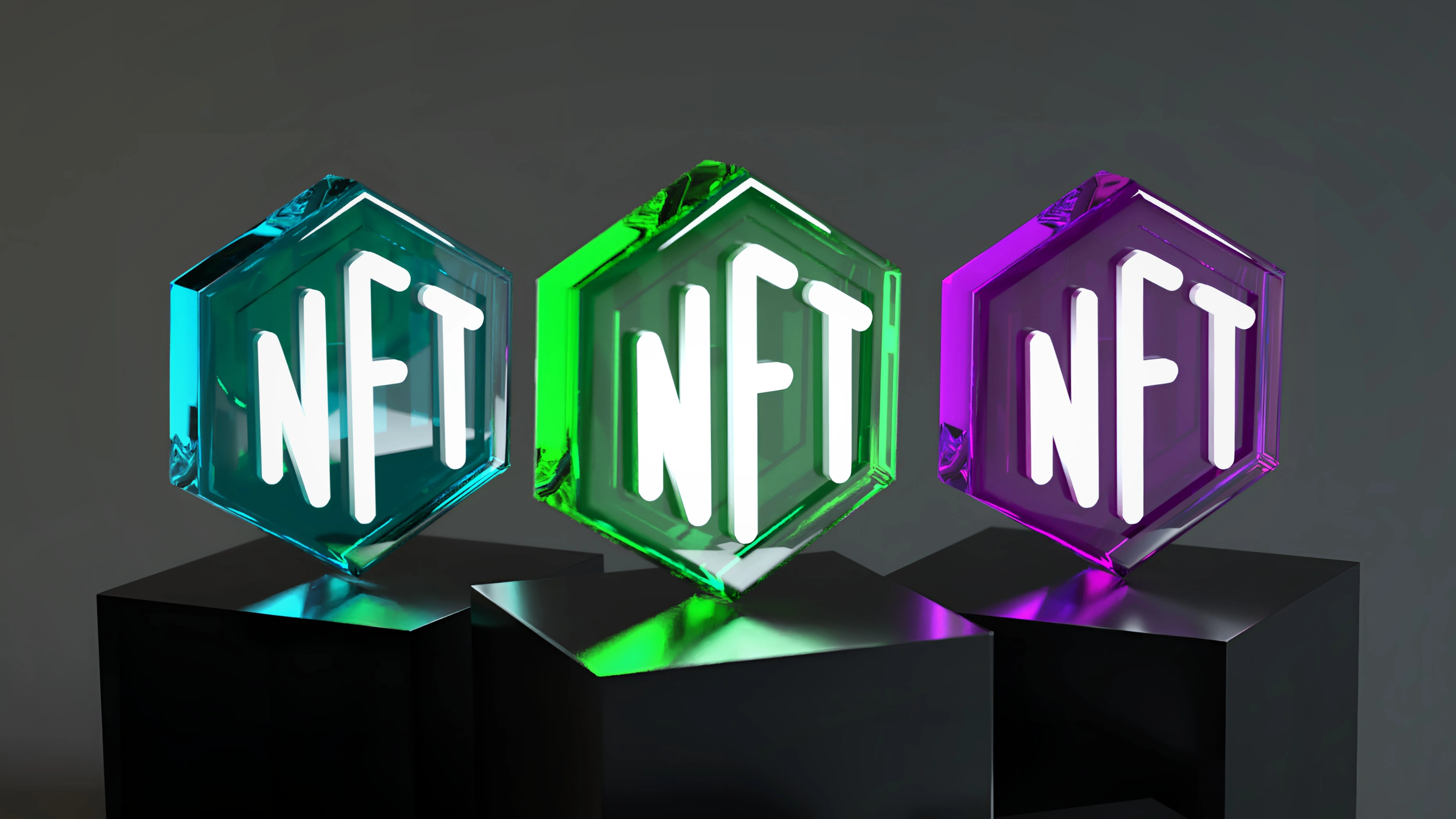
Non-fungible tokens (NFTs) are one of the newest applications of blockchain technology. These cryptographic tokens sit atop blockchains, which are essentially decentralized databases. Unlike different cryptocurrencies, NFTs have unique identifying metadata that separate them from other similar digital assets. These metadata make each NFT unique, much like real-world collectibles like paintings or classic vehicles are unique, scarce, and valuable.
Perhaps the most well-known use case of NFTs is with digital artwork; however this new technology has a much more comprehensive range of applications. For example, NFTs show much promise in identity verification, property records, medical records, patents, and more. Essentially, anything that is unique (or non-fungible) in the real world can have a corresponding digital NFT record in the digital world. This immense opportunity opens up possibilities for applications in nearly every industry imaginable.
NFT technology emerged from the ERC-721 standard and became the ERC-1115 standard. This smart-contract technology creates the threshold for the minimum quantity and quality of data needed to execute the smart contract and create a non-fungible, ownable asset. The newer protocol is more efficient and can reduce transaction and storage costs for transactions. Instead of needing an individual contract for each NFT, several can now be grouped into a single contract.
Ultimately, these are stored on the blockchain using decentralized ledger technology. This massive decentralized database stores all the necessary information for NFT trading and safekeeping. Like cryptocurrencies, NFT ownership is validated through data stored on the blockchain. Therefore, any trade or sale of different NFTs must occur through a cryptographic validation process that verifies token ownership.
A token is a digital asset built atop a pre-existing blockchain. Tokens may behave as if they were a cryptocurrency, but they can also be any sort of digital asset that is not a cryptocurrency. Tokens are often blockchain records of other digital or real-world assets. New web3 projects are beginning to tokenize tangible assets such as real estate, gold and silver bullion, and more. This innovation in tokenization makes ownership of assets (digital or otherwise) much easier to verify, streamlining the transaction process.
Fungibility refers to the property of one asset being able to take the place of another asset without affecting the value transferred. Fungible digital assets are items like cryptocurrencies, which can easily replace identical units — one bitcoin can replace another bitcoin without any loss in value.
Non-fungible tokens cannot be replaced with an identical token primarily because identical NFTs, strictly speaking, don’t exist. The characteristic of non-fungibility is one of the reasons that these digital assets can be worth anything at all. Because they are not fungible, they are absolutely unique and cannot be replaced with any other asset.
This uniqueness solved one of the biggest problems of the digital world: the ability to make carbon copies. Because information can be easily copied and transferred on the internet, it is easy to take a picture of the Mona Lisa and distribute it to the whole world. However, NFTs are the digital equivalent of actually owning the Mona Lisa. Additionally, because these NFTs are stored on the blockchain, their ownership status can be absolutely verified and proven.
This characteristic of non-fungibility is also the same trait that allows NFTs to be attached to real-world items like real estate. Real estate is also non-fungible, generally speaking. When an item has unique properties, that item can have a parallel digital existence in the form of an NFT. This duality helps facilitate proof of ownership and transactions.
NFTs and blockchain technology are inseparable. Having a non-fungible token without the underlying blockchain substructure is impossible. Blockchain technology with decentralized ledgers and cryptography provides the backbone of blockchain functionality. Decentralized ledgers allow NFTs to be stored and accessed in a location-independent manner.
This link to blockchain means that the NFT records exist so that even if one node holding the ledger were corrupted, other nodes with replicate ledgers would correct the error. Distributed Ledger Technology (DLT), combined with NFTs, makes token storage and verification extremely easy and safe. DLT can also demand credentials from people trying to access a given piece of information. For example, this security would be paramount when storing home deeds and property registries on the blockchain. The decentralized nature of the blockchain would help keep the assets safe from any attacks attempting to change asset ownership through database corruption.
NFTs could also be a stand-in for personal identity. For example, only people with HIPAA credentials could access a patient’s medical records when storing medical information. Instead of using a password, an NFT could be used as a non-fungible substitute for someone’s identity and minimize the possibility of leaked personal information or privacy breaches.
Finally, many commonly traded NFTs are denominated in units of cryptocurrency. To own a piece of digital artwork or a plot of digital real estate, one must first hold a portion of cryptocurrency. Cryptocurrencies are even more reliant on the blockchain than NFTs and are the unit of account for NFTs. Not only are NFTs traded with blockchain currencies, but their entire ownership structure is memorialized on the blockchain.
If you ask 10 different people how many different types of NFTs there are, you’ll likely get 11 different answers. Every current and future use case has a different kind of NFT, from digital art and digital real estate to virtual IDs and patents.
One of the most prominent use cases of NFTs is for collectibles. These are digitized versions of real-world events (such as pictures) or tokenized digital phenomena. Just like regular collectibles, factors such as rarity, prominence, and scarcity all influence the value of an NFT collectible.
One of the most famous examples of an NFT collectible is Jack Dorsey’s first tweet on Twitter. His tweet, “just setting up my twttr” sold for the equivalent of $2.9 million. These collectibles allow people to memorialize important events like the CEO of one of the largest social media platforms making his debut on that platform.
Pictures and videos of different sporting events and professional athletes have been tokenized and gained much prominence. For example, Lebron James famously became an NFT with his two-handed reverse windmill slam dunk against the Houston Rockets during their game on February 6, 2020. This particular NFT sold, at one point, for $210,000.
Digital artists, in particular, are finding a home and refuge within the NFT market. Many artists believe that agents, record labels, and licensing agencies get the better end of creative deals. However, NFTs allow creators to memorialize their terms of sale and ownership at the moment an NFT is minted.
Because NFTs are built atop a blockchain, there is no doubt about a given piece's authenticity. Additionally, there is never any doubt regarding an NFT's ownership status.
Creators also get an extra level of control over their artwork. Many artists will integrate resale royalties into an NFT's code and smart contract. Historically, artwork has become most valuable after its first sale and most frequently in the very last days of an artist's career or even post-mortem. Retaining resale royalties allows artists to continue to make money even after the work has been completed and the first sale made.
Another use of NFTs is in the acquisition of digital real estate. Several different metaverse companies have begun creating their own digital works with a finite number of plots of land. Projects like SANDBOX and Decentraland have created digital worlds. Big names like JPMorgan Chase, Snoop Dogg, and HSBC have already purchased and established online banking locations (or domiciles in the case of Snoop) within the metaverse.
Digital real estate, for the time being, is also limited in its supply much in the same way traditional real estate is. Similarly, metaverse users and web3 citizens represent a population that will continue to grow in the coming decades. This leaves a scarce asset with a growing number of individuals who wish to own it.
Ever since the two platforms in question — SANDBOX and Decentraland — launched, demand for digital real estate and the asking prices have increased substantially. These digital spaces could have easily been separate websites or shared environments, such as videogames. However, NFT technology allows individuals to create a registry of ownership and alienate their property at their convenience, which has never been possible.
Within the real world, NFTs can be used to make digital, non-fungible representations of any number of objects and people. As a result, there is nearly endless opportunity for applications regarding some of the most critical aspects of our lives. For example, NFTs can help with identity management, real estate records, legal documents, contracts, and more.
Because of an NFT’s link with the blockchain, NFTs are immutable. A powerful combination can result when applied to other immutable characteristics — like an individual’s identity. These sorts of personal identity NFTs can be used to access privileged information. At a future date, they may be used as digital identifiers that allow users to access everything from bank accounts to social media accounts.
Distributed ledger technology can maintain a complete registry of different identities. Because it is immutable, this data cannot be changed and can be used to verify a user's identity. As a result, identity theft would become exceedingly difficult to commit, as would other identity-based crimes like home-title theft.
Private blockchains (rather than public blockchains) would also add an additional layer of security on top of decentralized ledger technology. Finally, asymmetrical defense in the form of encryption would help verify and safeguard personal identity.
NFTs are currently not widely used within real estate, but some companies are creating small inroads into the space. Records would be stored on a blockchain, which has two main advantages. First, because the blockchain is immutable, property titles cannot be stolen. Any property transfer would have to happen with the express consent of the property owner. Additionally, it would be effortless to ascertain who is the actual property owner. While not common in the U.S., many countries worldwide have problems with people selling parcels of real estate that do not belong to them. Tokenized real estate could be easily verified and would not be misleading because the information is immutable.
Additionally, real estate could be combined with smart contracts. When transacting a piece of property between two or more people, the smart contract could act as an escrow account. This would bring an extra level of safety into the property transaction. Funds destined for the property holder could be stored on the blockchain, and the property would transfer from one owner to another once the funds were released. This would happen automatically and nullify the need for trust between two parties that don't know each other and may not even live in the same country or speak the same language.
NFTs also have exciting applications within the legal sphere. Within the last several years, online signature technologies have appeared. Many have benefitted from the ease with which these documents can be signed — for generic, low-risk contracts, it's no longer necessary to appear in person to sign a document. Simply clicking a box or pasting a signature into a PDF is now considered sufficient. However, there is a problem with originality.
Physical, legal documents can be proven original upon examining signing dates and the presence of ink from a pen. However, it’s all too easy to create digital copies of a digital document and erase the original copy so that no original exists. This leads to difficulties within contract law where no original exists.
However, NFTs can easily represent a contract, even a digital contract, which can be stored on the blockchain. This is not exactly a smart contract, though smart contracts would likely solve this problem too. For example, the identity or the entire original contract could be stored as a token on the blockchain. It would then become immutable, and anyone with the necessary credentials would be able to access the contract for reference.
NFTs backed by cryptocurrencies can be purchased on various digital asset exchanges and NFT marketplaces. The first step in buying an NFT is to convert local currency to a cryptocurrency like Ethereum. This can be done on any number of cryptocurrency exchanges. Later, this cryptocurrency must be traded for an NFT. These transactions occur within a digital wallet where all the different digital assets — cryptocurrencies, tokens, and NFTs — will live.
Currently, the one major problem with NFTs is that the market is still very new and somewhat immature. Many people, especially Millennials and Gen Z, have taken to NFT digital artwork, but this is certainly not the correct asset for everyone. Many ask themselves why they would want to "own" a piece of digital artwork when they can merely take a screenshot and obtain nearly the same enjoyment.
However, when considering the totality of the functionality of NFTs — their applications in medicine, law, real estate, currencies, and more — the future becomes significantly brighter.
The future of NFTs continues expanding into more areas of prominence and import. The NFT/smart contract/cryptocurrency trifecta shows immense promise to transform the way that modern commerce happens. NFTs will act as digital representations of physical goods, smart contracts will trustlessly manage transactions, and cryptocurrencies will be the medium of value transfer. The implications for international commerce, real estate, insurance, and anything requiring a contract are massive.
Additionally, as the metaverse becomes more prevalent, the demand for NFTs will likely also increase. NFTs, especially to the extent that they become virtual goods, are likely to hold a prominent role in the metaverse. Enterprises like Nike and Vans have already started creating spaces within the metaverse and minting NFT products. It is likely that more enterprises, especially retailers, will continue this trend of creating and selling branded NFTs.
NFTs will disrupt some industries while creating new revenue opportunities for others. The key to navigating these uncharted waters is gaining a fundamental, first-principles understanding of blockchain and blockchain assets like NFTs. The Wharton School created the Economics of Blockchain and Digital Assets course to help financial professionals navigate the new environment created by blockchain. The blockchain certification course features more than 80 videos, seven industry-leading case studies, and three crypto valuation models. In addition, attendees will learn projected token-utility value, discounted token-staking value, and implied token-governance value. For more information on the program or to enroll, visit our information page to learn more.
This article is for marketing purposes only and does not intend to represent the opinions of the program.


